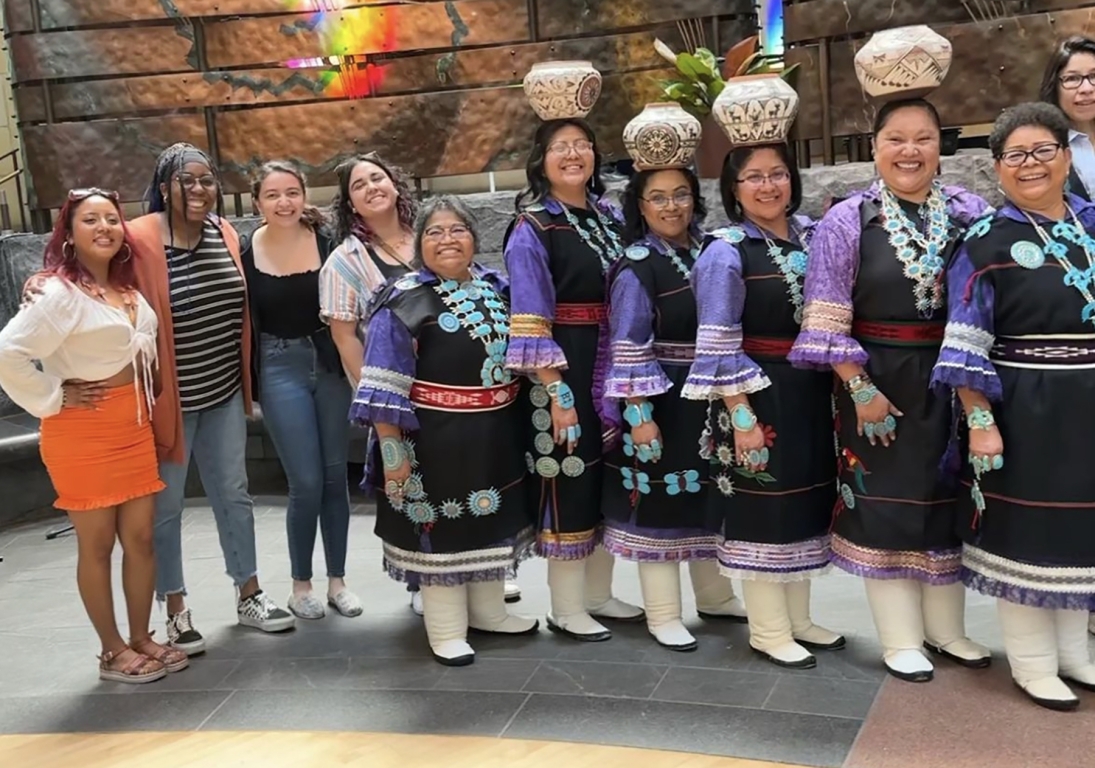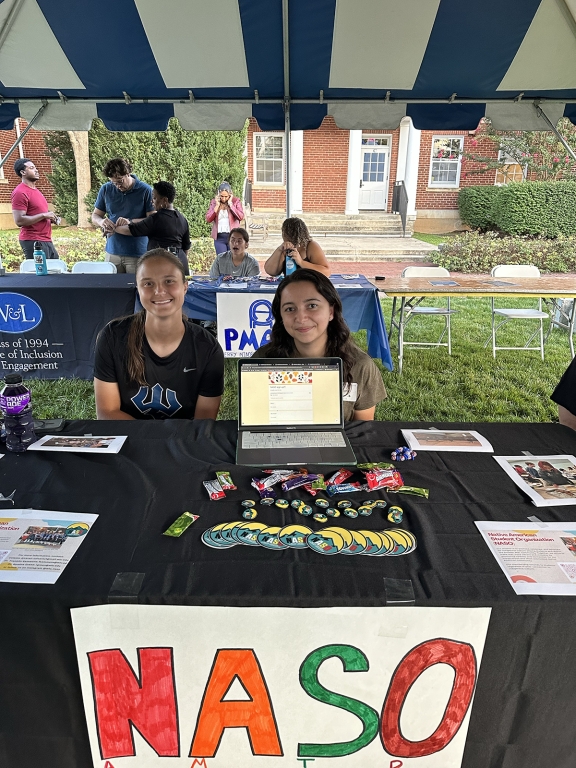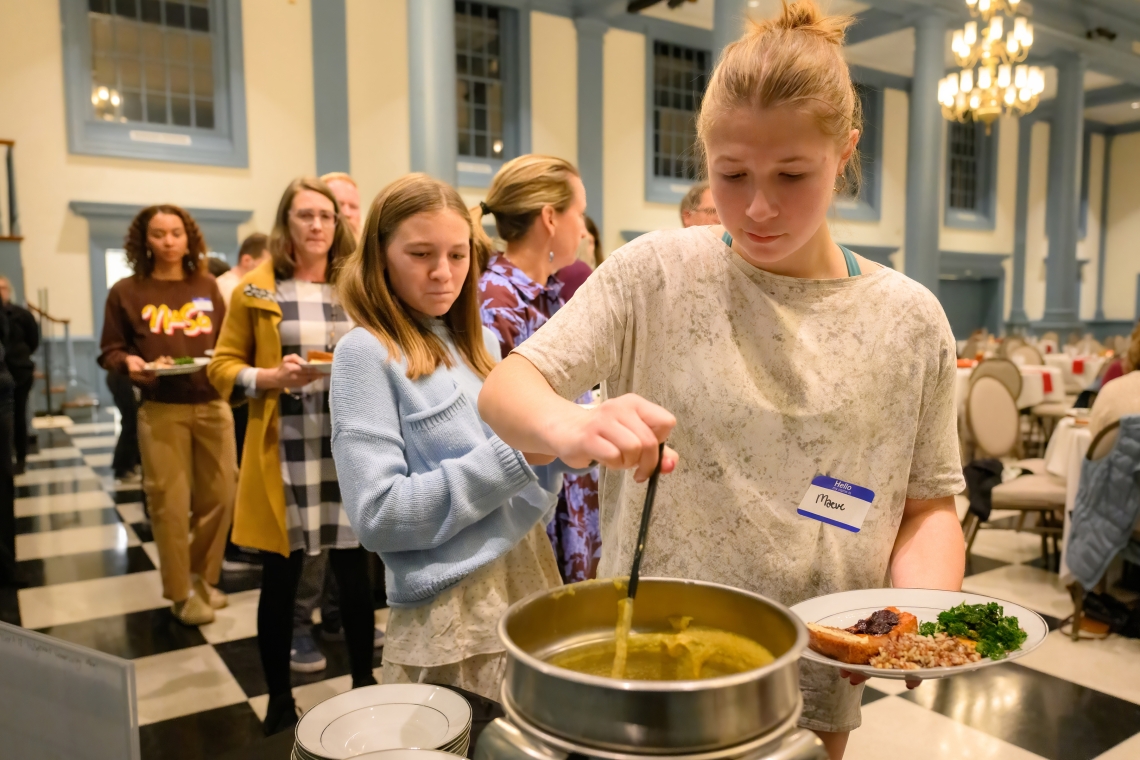Student Organization Spotlight: Native American Student Organization W&L’s Native American Student Organization (NASO) connects the campus to educational programming, events and resources celebrating Indigenous history, culture and community.
W&L’s Native American Student Organization (NASO), in partnership with Campus Kitchen and W&L’s Native American and Indigenous Cohort, recently offered the campus community the opportunity to gather in Evans Hall for an autumn-inspired meal inspired by traditional Indigenous ingredients while engaging in small group discussions on the influence of Indigenous wisdom and foodways, the impact of the modern Thanksgiving narrative and how participants can learn more about the diverse cultural traditions of Indigenous peoples during Native American History Month.
Celeste Alvarez ’26, a sociology and anthropology major from Hereford, Texas, who serves as NASO’s president, said her proudest achievement as a member of NASO occurs every year when the organization offers its annual Indigenous Community Meal to the W&L community.
“The annual Indigenous Community Meal is only possible because of the immense support we receive from co-sponsors and departments and the amazing work done by the catering staff,” Alvarez said. “Many people are involved in the planning, and I am proud of the work done by all of us to ensure that the meal continues occurring every year as a place where the community can come together in conversation.” Alvarez added that the event would be impossible without W&L’s Native American Employee Resource Group, the Campus Kitchen staff and NASO’s faculty advisers and assistant professors of history, Franklin Sammons and Romina Green.
NASO, founded in 2021, is a relatively new organization on W&L’s campus. The organization boasts around 70 members and is still growing; Alvarez said there is plenty of room for new students to shape the direction and initiatives of the group. NASO is focused on expanding its educational programming and community outreach, so new students can contribute ideas, organize events and help build partnerships with other campus and local organizations. The group is also working on researching and highlighting the history of Indigenous alumni at W&L, and new students could get involved with research and documentation.
Alvarez spent a semester abroad last year in Oaxaca, Mexico, participating in a program that focused on Indigenous identities in southern Mexico, particularly the Zapotec and Mixtec peoples. Alvarez said the experience inspired plans for upcoming events that foster community and connect students with tribal knowledge.
“I’ve learned so much about the importance of collaboration, especially with local communities,” Alvarez said.
The organization also works closely with the university’s Native American and Indigenous Cohort, which hosts events and leads campus initiatives to educate the W&L community on the institution’s Indigenous history. The campus rests on land once occupied by the Yesá people and their descendants, among them the Monacan, and the organization has sought to connect the W&L community to the lived experience of tribal communities in a variety of ways. NASO has hosted panel talks with professors who have studied Indigenous cultures or who identify as Native American, providing diverse perspectives and Q&A sessions for students. The group also frequently brings guest speakers to share their expertise and offer advice on fostering a community for Native American students. Throughout the academic year, NASO organizes visits to nearby powwows and museum exhibits to give students firsthand experiences and learning opportunities about Indigenous cultures in the region. The group recently helped curate a book display at Leyburn Library to highlight literature and resources related to Native American history and culture.
Alvarez and Jessica Wager, assistant director of institutional history at W&L, recently discussed their community-based approach to Native American history research as part of the Lenfest Center for the Arts’ new Outreach & Engagement (O&E) Series. The event was an opportunity to introduce attendees to the region’s history or build upon their existing understanding of regional Native American peoples and lands and how W&L is intertwined with them. Alvarez said NASO is excited about future educational programming that taps into the talents of W&L’s campus community.
“I am looking forward to organizing a beading workshop with Kelly Fujiwara [Lee House events coordinator and a founding member of the Indigenous Cohort] where students can learn the history and significance of beading and attempt to do basic beading techniques,” Alvarez said, adding that NASO hopes to create more partnerships with other Indigenous student groups at neighboring institutions.
Calla Andrews ’27, a citizen of the Cherokee Nation from Tulsa, Oklahoma, who is double majoring in biology and environmental studies, said attending the Rappahannock Powwow at the Rappahannock Regional Tribal Center, an annual event incorporating multiple regional tribes in Virginia, was one of the highlights of her NASO involvement this year.
“You’re celebrating the culture of the tribe hosting the powwow, but it’s also a way to celebrate our shared culture as Indigenous people and just the idea of community itself,” Andrews said. “Community is a vital part of our culture, no matter what tribe you are, and so having these events where the community can gather is super important.”
“Community and a shared goal in celebrating Indigenous identities are what bring us all together,” Alvarez said, “and I hope to organize and participate in events where we can come together and celebrate our shared goals.”
Follow NASO on Instagram to learn more about upcoming events and getting involved.
 NASO at the Smithsonian National Museum of the American Indian last spring
NASO at the Smithsonian National Museum of the American Indian last spring NASO’s table at the annual Student Activities Fair
NASO’s table at the annual Student Activities Fair Students, faculty and staff lined up in Evans for great food and discussion at the fourth annual Indigenous Community Meal on November 12.
Students, faculty and staff lined up in Evans for great food and discussion at the fourth annual Indigenous Community Meal on November 12. The organization collaborated with the Library Student Advisory Board to create a book display for Native American Heritage Month.
The organization collaborated with the Library Student Advisory Board to create a book display for Native American Heritage Month.
You must be logged in to post a comment.